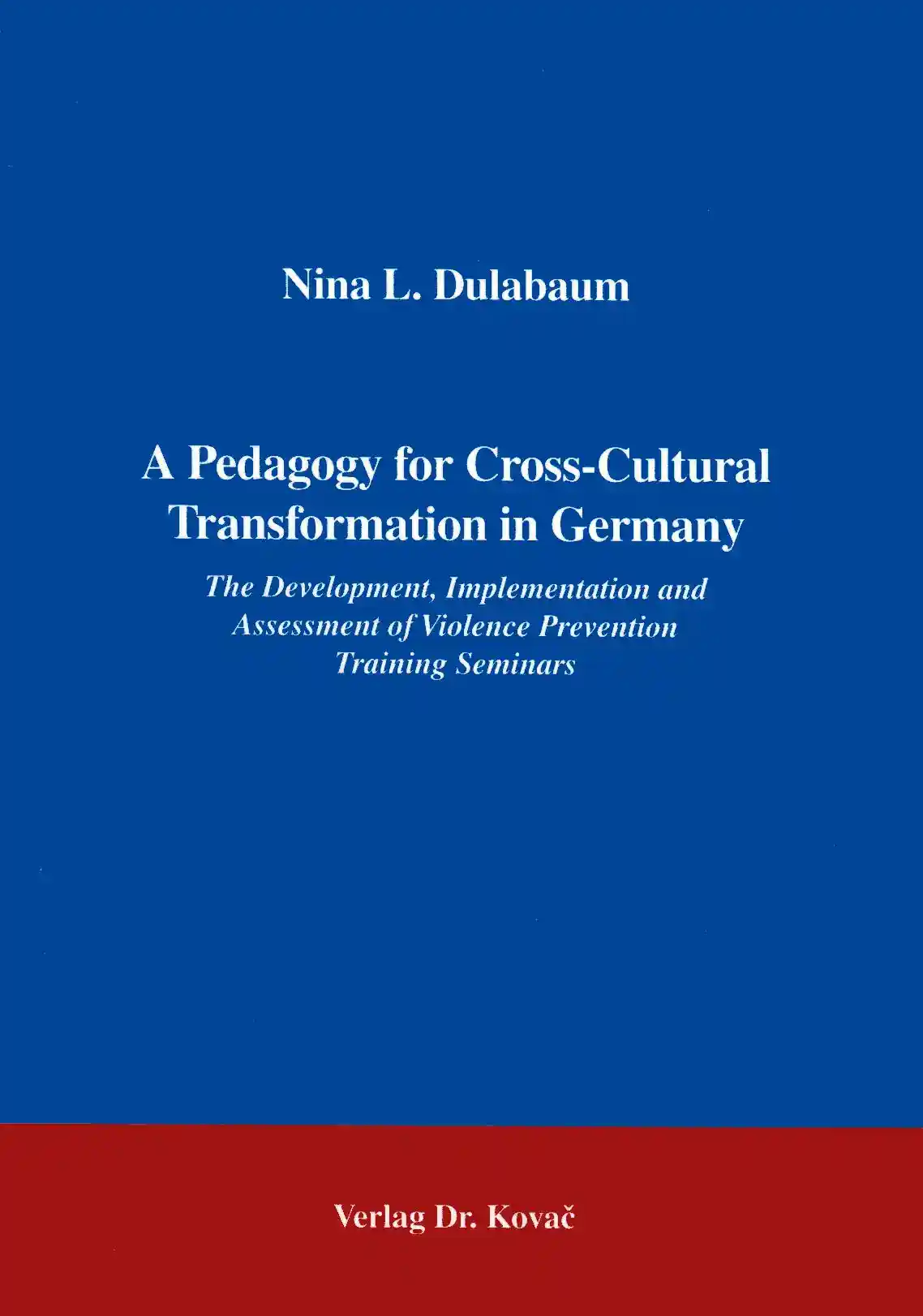Nina L. DulabaumA Pedagogy for Cross-Cultural Transformation in Germany
The Development, Implementation and Assessment of Violence Prevention Training Seminars
EUB. Erziehung – Unterricht – Bildung, volume 54
Hamburg 1996, 290 pages
ISBN 978-3-86064-496-6 (print)
About this book deutschenglish
"The purpose of this research was to investigate the development, implementation and assessment of violence prevention training seminars in Germany. This research builds on the main conclusions of my master's thesis, "Educated to be 'Racist'" (1991) which posed two major challenges for educators in the future: 1. Addressing the widespread escalation of "racism" and related violence in Germany, which is often insiduously accepted as "status quo" and perpetuated via multi-media forums, textbooks, legislation, etc.; 2. Developing and implementing training programs to better equip students and adult educators to address "racist" attitudes, "racial" violence and related cross-cultural or intercultural conflicts and communication barriers. Violence is a relevant theme in both the United States and Germany and there is an increasing awareness as well as a growing consensus on the necessity of violence prevention programs. This is the "backdrop" of this research and is discussed in Chapter 1: the general escalation of violence, violence related to "race" and hate crimes, violence in Germany and violence and education. Although Germany has yet to suffer the extent of violence found on a daily basis in the United States, there is evidence documenting an increase in violent crimes and murders. In addition, the abrupt escalation of explicit right-wing violence against nonGermans hit the press in sensationalized form following the pogroms of Rostock and Hoyerswerda and the murderous assaults at Moelln and Sollingen. Intrinsic in this research is the conviction that it is necessary to broaden our understanding of the origins and sources of violence and conflict and to begin to address such important underlying issues as culturally sanctioned prejudiced attitudes and "racism", the widespread phenomenon of scape-goating, and such power hierarchies within society as "insiders versus outsiders", "male versus female", etc. Furthermore, it is important to discern the "normal" socialization processes which impede intercultural and cross-cultural dialogues. Thus, the framework of the training seminars were designed to integrate the following: 1. Cross-cultural conflict transformation principles, including nonviolent training as well as strategies for cross-cultural conflict resolution or dispute resolution; 2. Basic principles on dealing with prejudice/"anti-racism" education; 3. Basic principles of intercultural communication. Hence, violence prevention within the parameters of this research integrates these three different but intricately related areas of emphasis, and three basic stages: 1. Development, 2. Implementation, 3. Evaluation. The first task involved a thorough analysis of theories and programs related to these three areas and exploring their many points of intersection in order to develop educational seminars and programs for school seminars, youth workshops and adult weekend seminars. This entailed an initial extensive international documentation and survey of methodologies. The greater portion of materials pertaining to these three areas of analysis were available in the United States, given that a wide variety of training institutes and school-based programs have been initiated since the civil rights movement, and especially in the last 15 years. It became evident that this research would have to address the issue of transference - translating in a technical, conceptual and situational sense, primarily U.S. conflict "resolution" or what I prefer to denote as transformation approaches to both a former West and East German setting. Based on established and successful program designs and theoretical underpinnings, two seminar prototypes were developed. These seminars were structured to facilitate nonviolent communication skills and heighten awareness, or "conscientization", through holistic experiental learning incorporating cognitions, behaviors and emotions. Through interaction with each other, new theoretical concepts and personal experiences would be explored. As Ira Shor submits: "Critical education has to integrate the students and the teachers into a mutual creation and re-creation of knowledge" (Freire/Shor 1987, 8). Chapter 2 provides extensive background information on the various programs in the United States and Germany, from which I then synthesized in designing the training seminars. Seminar implementation and assessment, Stage II and Stage III, involved leading the same seminar design with varying target groups of all ages - in schools, at universities and with professionals - and evaluating the effectiveness, in teaching people how to deal with conflict and violence. In Chapter 3 I discuss in great detail, the process of developing a general seminar framework, integrating multifaceted and holistic modalities of learning. Accordingly, in Chapter 4, I discuss designing a suitable assessment methodology to incorporate a multidimensional design for data collection with participants and then draw from at least a few different data banks in evaluating the effectiveness of the seminars. I turned to action and participatory research designs, given that these are the main methodologies advocating horizontal versus vertical research relationships. In seeking a participatory methodology for seminar evaluation compatible to my seminar philosophy and design, I designed a very intricate procedure for analysis of interview transcripts: The CEPPP - The Contextual-Ethnographic-Participatory and Phenomenological Paradigm. This enabled me to code, classify and analyze participant responses, utlizing their "in vivo" interpretations and language in identifying emergent themes. Moreover, the principle of "structural corroboration" or "triangulation" was employed, i.e., the research design included various sources of data to compare, which served as a check for reliability and verification. Although emphasis was placed on gathering qualititative data, pre- and post-seminar questionnaires were used with three different target group which included quantifiable questions, once again, in order to contrast to other data. Upon initial codification and classification of all the data, I began a comprehensive series of comparative analyses, based on the grounded theory methodology (Glaser/Strauss 1967). Upon completion of the comparative analyses, all participant themes had been coded, categorized, compared and the MAIN EMERGENT FOCI had been identified. On a conceptual level, as I analyzed and interpreted the various FOCI, I began to identify clusters or subgroups of FOCI pertaining to one central issue related specifically to evaluation of these seminars. I identified these central clusters as "PARAMETERS" for effective leadership, implementation and improvement of these training seminars, for they basically synthesized the central issues of all the data pertaining to assessment. These research findings are discussed in Chapter 5.Keywords
Antirassistische ErziehungEffektive SeminarführungGewaltpräventionInterkulturelle KommunikationKonfliktMediationPädagogikQualitative EvaluationsforschungIhr Werk im Verlag Dr. Kovač

Möchten Sie Ihre wissenschaftliche Arbeit publizieren? Erfahren Sie mehr über unsere günstigen Konditionen und unseren Service für Autorinnen und Autoren.
